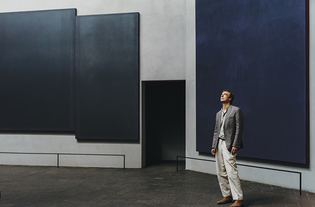
Max Burkhalter
Mark Rothko, Class of 1925, died before the chapel he designed had been completed. His son, Christopher Rothko ’85 (at right), is now working to restore his father’s vision.
View full image
Christopher Rothko ’85 has worked as a clinical psychologist and a music critic, but now he devotes much of his time to the interfaith Rothko Chapel in Houston, designed by his father in the mid-1960s and commissioned by Dominique and John de Menil. The de Menils wanted a modern iteration of a sacred space; the chapel became a center for social justice work, cultural events, educational outreach, and a biennial award for grassroots activism. Its 14 huge paintings—one of the largest is 15 by 11 feet—may look black, but the play of natural light reveals pigmented layers that subtly shift the hues to purples. Rothko is chairing a 50th anniversary campaign and has raised $23 million of the $30 million needed for renovation.
Maria Ricapito: Tell me about the Rothko Chapel and what role you see it playing in the future.
Christopher Rothko: The chapel is now very, very close to my father’s original vision. We once again have a beautifully open room with a skylight that allows some contact with the outside world and allows the paintings to be lit by natural light. Every time you go into the chapel, it’s different—the time of year, the time of day, the weather—but it’s also different because, although the paintings stay the same, we’re changing all the time. It’s a barometer, psychologically, of where you are at that moment.
MR: I have been there and I know—it’s a mood thing.
CR: This [campaign] was the result of having been at the chapel with people who knew and loved my father’s work and knew that space very well. We understood that—as magical as the experience still was—it wasn’t right.
MR: How so?
CR: My father received this dream commission, a project with the high seriousness of his work. Over time the commission was fully realized, but he died before it was constructed. For reasons nobody can quite explain, some of the things he had in his own studio to soften the light of the skylight were never [put] in place, and it was not good for the paintings.
MR: You must have been just a little boy when this was being designed and developed. Do you remember the first time you went to the chapel?
CR: I remember being in the studio when my father worked on these paintings, although I don’t think I understood the full import of what he was doing. But I visited the chapel, for the first time, in 1996 for the 25th anniversary. There was a fabulous show documenting the history of that commission and what happened in my father’s career following it. I understood, in that moment, a good deal about what he’d always been after in his artwork—that he wasn’t simply trying to engage you on an aesthetic level, that he wasn’t simply trying to get into your emotional life through color, but that, in fact, he really wanted to have a conversation with you. He wanted to ask you the big questions about being a human being—those existential questions, “Why are we here? And what does it mean? And what happens next?” Usually they’re in the background, under the surface. His whole purpose through his artwork was to bring those questions into active contemplation. The chapel was the ultimate place for him to do that.
 loading
loading